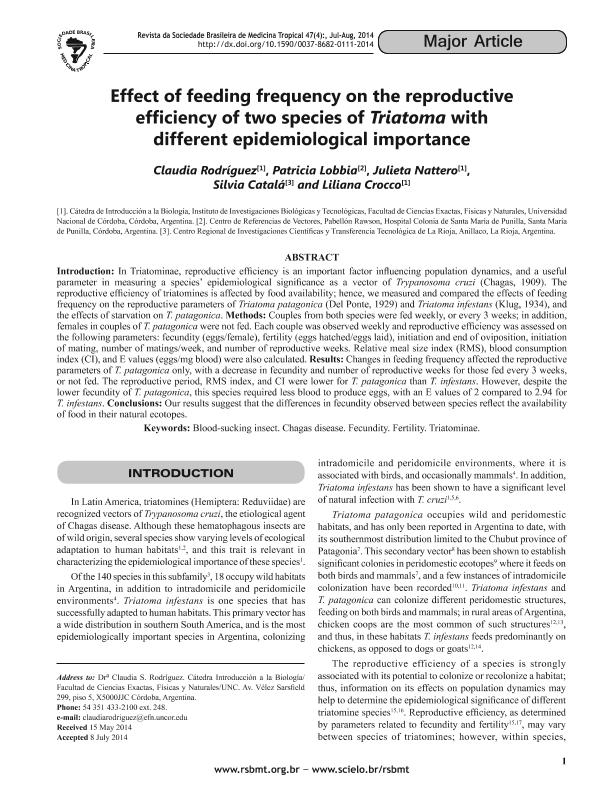Artículo
Effect of feeding frequencies on the reproductive efficiency for two species of Triatoma of different epidemiological importance
Rodriguez, Claudia Susana ; Lobbia, Patricia Alejandra
; Lobbia, Patricia Alejandra ; Nattero, Julieta
; Nattero, Julieta ; Catala, Silvia Susana
; Catala, Silvia Susana ; Crocco, Liliana
; Crocco, Liliana
 ; Lobbia, Patricia Alejandra
; Lobbia, Patricia Alejandra ; Nattero, Julieta
; Nattero, Julieta ; Catala, Silvia Susana
; Catala, Silvia Susana ; Crocco, Liliana
; Crocco, Liliana
Fecha de publicación:
07/2014
Editorial:
Soc Brasileira Medicina Tropical
Revista:
Revista Da Sociedade Brasileira de Medicina Tropical
ISSN:
0037-8682
e-ISSN:
1678-9849
Idioma:
Inglés
Tipo de recurso:
Artículo publicado
Clasificación temática:
Resumen
Introduction: In Triatominae, reproductive efficiency is an important factor influencing population dynamics, and a useful parameter in measuring a species' epidemiological significance as a vector of Trypanosoma cruzi (Chagas,1909).The reproductive efficiency of triatomines is affected by food availability; hence, we measured and compared the effects of feeding frequencyon the reproductive parameters of Triatoma patagonica (Del Ponte, 1929) and Triatoma infestans (Klug, 1934), and the effects of starvation on T. patagonica. Methods: Couples from both species were fed weekly, or every 3 weeks; in addition, femalesin couples of T. patagonica were not fed. Each couple was observed weekly and reproductive efficiency was assessed on the following parameters: fecundity(eggs/female),fertility (eggs hatched/eggs laid), initiation and end of oviposition, initiation of mating,number of matings/week, and number of reproductive weeks. Relative meal size index (RMS), blood consumption index (CI), and E values (eggs/mg blood) were also calculated. Results: Changes in feeding frequency affected the reproductive parameters of T. patagonica only, with a decrease in fecundity and number of reproductive weeks forthosefedevery 3 weeks,or not fed. The reproductive period, RMS index, and CI were lower for T. patagonicathan T. infestans. However, despite the lower fecundity of T. patagonica,this species required less blood to produce eggs, with an E-value of 2 compared to 2.94 for T. infestans. Conclusions: Our results suggest thatthe differences in fecundity observed between species reflect the availability of food in their natural ecotopes.
Palabras clave:
Blood-Sucking Insect
,
Chagas Disease
,
Fecundity
,
Fertility
,
Triatominae
Archivos asociados
Licencia
Identificadores
Colecciones
Articulos(CRILAR)
Articulos de CENTRO REGIONAL DE INV. CIENTIFICAS Y TRANSFERENCIA TECNOLOGICA DE ANILLACO
Articulos de CENTRO REGIONAL DE INV. CIENTIFICAS Y TRANSFERENCIA TECNOLOGICA DE ANILLACO
Articulos(IEGEBA)
Articulos de INSTITUTO DE ECOLOGIA, GENETICA Y EVOLUCION DE BS. AS
Articulos de INSTITUTO DE ECOLOGIA, GENETICA Y EVOLUCION DE BS. AS
Citación
Rodriguez, Claudia Susana; Lobbia, Patricia Alejandra; Nattero, Julieta; Catala, Silvia Susana; Crocco, Liliana; Effect of feeding frequencies on the reproductive efficiency for two species of Triatoma of different epidemiological importance; Soc Brasileira Medicina Tropical; Revista Da Sociedade Brasileira de Medicina Tropical; 47; 4; 7-2014; 430-436
Compartir
Altmétricas



